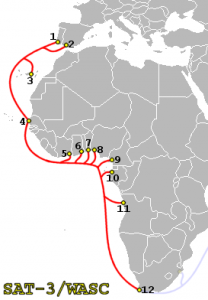
It appears Internet connectivity on the African continent especially in Ghana and Nigeria is about to get better soon. The Ghana News Agency (GNA) reports the launch of yet another private effort to improve Internet connectivity in Africa:
Work has begun on a 200-million dollar undersea fibre optic cable, which aims to provide reliable Internet and telecommunication services to industry stakeholders across Ghana and Nigeria.
The project being undertaken by Main One Cable Company will help to minimize the difficulties of switching traffic between African countries and eliminate the inconveniences and added cost of first routing traffic to Europe.
More information:
The company has already begun laying the cables, which will run from Portugal to Ghana and Nigeria to enhance efforts to digitally connect Africa with the rest of the world.
Speaking at a press briefing in Accra to officially announce the commencement of work, Ms Funke Opeke, Chief Executive Officer of the company said the first phase of the project is expected to be completed in May 2010.
The first phase spans 6,900 kilometres extending from Portugal to Ghana and Nigeria with an additional 6,000 Kilometres extension to South Africa and Angola in the second phase.
This is not exactly the first effort. I am aware that Globacom Ltd, the second national operation (SNO) in Nigeria is currently building a similar cable through the Atlantic from Nigeria, through Benin Republic, Ghana, Senegal, Portugal, to the United Kingdom. Globacom’s fibre optic network is called Glo-1 and expected to be commissioned for commercial activities in March 2009.
Other fibre optic cables are in the pipeline for West Africa:
- The West African Festoon System, a Telkom-led project to link SA with Nigeria to address capacity problems on the existing Sat-3 system.
- The Africa West Coast Cable, an SA-led initiative to build a cable system between SA and the UK along Africa’s west coast. The high-speed system is meant as a replacement to Sat-3, which is expected to reach capacity in the next few years.
These optic connections are very important for Africa because only one active fibre optic called SAT-3/WASC (South Atlantic 3/West Africa Submarine Cable) serves West Africa presently. Too many Internet users especially in Nigeria, access the Internet through independent satellite connections (VSATs) and this creates a big problem as even local traffic is routed through Europe, North America or even South-East Asia. With more fibre optic connectivity options for West Africa, I expect that more businesses/organizations/ISPs would eventually move away from VSAT. I also expect the fibre optics to be connected at some point, through an Internet exchange. At that point, real Internet would have been coming to Africa.





Interesting. Based on my research, the globacom cable was supposed to provide service to Ghana as well.
[…] cables are nearing completion this year whilst further cables are in development. David Ajao has coverage of the Main One cable, expected to serve Ghana and Nigeria in its first phase, before extending […]
Hi,
That’s a good piece information and all things being equal, the Sub-Saharan states will soon enjoy fast internet access that we have, so far, been denied.
When a friend told me what we stand to enjoy if this becomes a success, I could only pray for the quick completion of this project that is going to change the way we go online.
Imagine watching videos, live matches, etc from the internet which for now is an almost impossible issue giving the state of slow connection in the West Africa States!
The Kenyans are also about to complete a number of cables. These are EASSy, TEAMS and SEACOM. The TEAMS cable will have a capacity of 1.2Tbps This will make it one of the highest bandwidths available in Africa. The SEACOM consortium has already suggested a ring around the entire African coastline which would link with the West African cables. This will mean that intra-African digital markets and connectivity will suddenly be realized. This is definately very good news for Africa.
[…] a lone cable (as well as thousands of expensive VSAT terminals) for 9 years is now being served by 3 active submarine fibre optic cables: SAT3, MainOne and […]
[…] was as intrigued about it being a freebie as I was with the potential speed. You see, Main One is a submarine cable system that carries gigabytes of data from Europe to West Africa and so, I expected their connectivity […]
[…] and there are plans to extend the cable system to South Africa. MainOne competes with SAT3 and glo-1 in West Africa. AKPC_IDS += […]
[…] WACS (West Africa Cable System) is a soon-to-be-launched submarine communications cable linking South Africa with the United Kingdom along the west coast of Africa. The cable is expected to land in the following African countries: South Africa, Namibia, Angola, the Democratic Republic of the Congo, the Republic of Congo, Cameroon, Nigeria, Togo, Ghana, Côte d’Ivoire, Cape Verde as well as the Canary Islands, Portugal and the United Kingdom. The design capacity of WACS is at least 3.84 Tbit/s, now upgraded to 5.12 Tbit/s – making it the fastest data cable into Africa. […]
[…] In case you missed the memo, Africa is rising. Having been largely ignored in the development of the Internet, things have been changing rapidly in the past decade with telecommunication companies forming alliances with financial institutions to bring serious data connectivity into Africa, and with it, lots of potential for prosperity. You can thus understand my excitement each time a new submarine cable is announced. […]